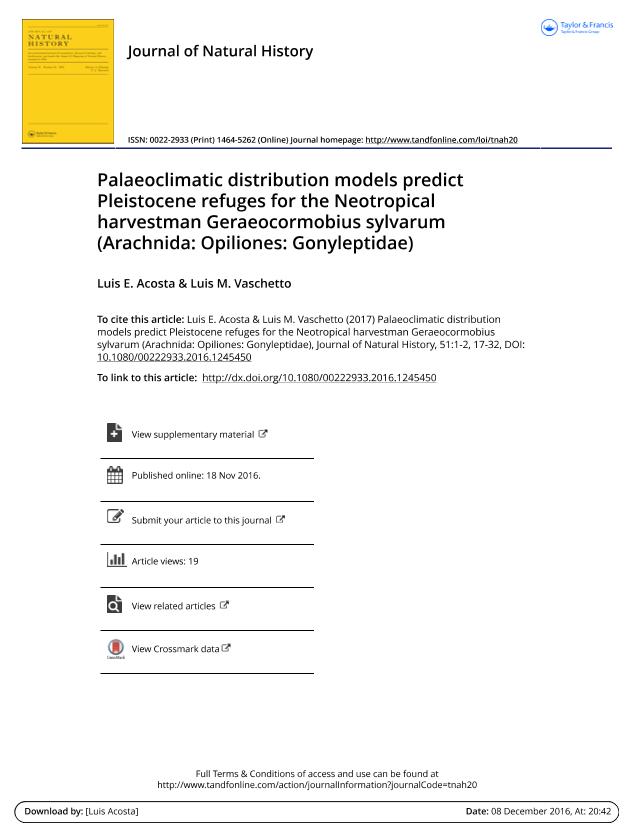Mostrar el registro sencillo del ítem
dc.contributor.author
Acosta, Luis Eduardo

dc.contributor.author
Vaschetto, Luis Maria Benjamin

dc.date.available
2018-07-05T19:53:17Z
dc.date.issued
2017-01
dc.identifier.citation
Acosta, Luis Eduardo; Vaschetto, Luis Maria Benjamin; Palaeoclimatic distribution models predict Pleistocene refuges for the Neotropical harvestman Geraeocormobius sylvarum (Arachnida: Opiliones: Gonyleptidae); Taylor & Francis Ltd; Journal of Natural History; 51; 1-2; 1-2017; 17-32
dc.identifier.issn
0022-2933
dc.identifier.uri
http://hdl.handle.net/11336/51429
dc.description.abstract
This paper primarily aims to test a Pleistocene refuge-type scenario, as previously proposed for the gonyleptid Geraeocormobius sylvarum, a semi-deciduous forests dweller in subtropical Argentina, Brazil and Paraguay. Palaeodistributional models of this species were built using MaxEnt for two Last Glacial Maximum (LGM = 21,000 years ago) simulations–Community Climate System Model (CCSM) and Model for Interdisciplinary Research on Climate (MIROC)–and for 6000 years ago (−6k = HCO, the Holocene climatic optimum). Both LGM models retrieved a fragmented pattern. For CCSM, range was split into multiple, scattered fragments. MIROC resulted in very few patches, with a decided range reduction because of a strong humidity drop. Models for −6k recovered a moderate range expansion. No past connection between the core area and the yungas was predicted. Analysis of variables importance showed that two precipitation predictors (bc18, precipitation warmest quarter; bc14, precipitation driest month) and two temperature predictors (bc7, temperature annual range; bc9, mean temperature driest quarter) scored as the most influencing overall. The Limiting Factor analysis recognized them as limiting too, in different parts of the species range. LGM palaeomodels of G. sylvarum are compatible with the refuge hypothesis invoked in previous molecular analyses, to explain the high genetic diversity found in the core area. Additionally, the results reinforced the hypothesis of the recent anthropogenic origin of the yungas disjunct populations.
dc.format
application/pdf
dc.language.iso
eng
dc.publisher
Taylor & Francis Ltd

dc.rights
info:eu-repo/semantics/openAccess
dc.rights.uri
https://creativecommons.org/licenses/by-nc-sa/2.5/ar/
dc.subject
Holocene Climatic Optimum
dc.subject
Last Glacial Maximum
dc.subject
Maxent
dc.subject
Palaeodistributions
dc.subject
Quaternary
dc.subject
Refuges
dc.subject.classification
Otras Ciencias Biológicas

dc.subject.classification
Ciencias Biológicas

dc.subject.classification
CIENCIAS NATURALES Y EXACTAS

dc.title
Palaeoclimatic distribution models predict Pleistocene refuges for the Neotropical harvestman Geraeocormobius sylvarum (Arachnida: Opiliones: Gonyleptidae)
dc.type
info:eu-repo/semantics/article
dc.type
info:ar-repo/semantics/artículo
dc.type
info:eu-repo/semantics/publishedVersion
dc.date.updated
2018-04-24T19:32:36Z
dc.journal.volume
51
dc.journal.number
1-2
dc.journal.pagination
17-32
dc.journal.pais
Reino Unido

dc.journal.ciudad
Londres
dc.description.fil
Fil: Acosta, Luis Eduardo. Consejo Nacional de Investigaciones Científicas y Técnicas. Centro Científico Tecnológico Conicet - Córdoba. Instituto de Diversidad y Ecología Animal. Universidad Nacional de Córdoba. Facultad de Ciencias Exactas Físicas y Naturales. Instituto de Diversidad y Ecología Animal; Argentina. Universidad Nacional de Córdoba. Facultad de Ciencias Exactas, Físicas y Naturales. Cátedra de Diversidad Animal I; Argentina
dc.description.fil
Fil: Vaschetto, Luis Maria Benjamin. Consejo Nacional de Investigaciones Científicas y Técnicas. Centro Científico Tecnológico Conicet - Córdoba. Instituto de Diversidad y Ecología Animal. Universidad Nacional de Córdoba. Facultad de Ciencias Exactas Físicas y Naturales. Instituto de Diversidad y Ecología Animal; Argentina. Universidad Nacional de Córdoba. Facultad de Ciencias Exactas, Físicas y Naturales. Cátedra de Diversidad Animal I; Argentina
dc.journal.title
Journal of Natural History

dc.relation.alternativeid
info:eu-repo/semantics/altIdentifier/doi/https://dx.doi.org/10.1080/00222933.2016.1245450
dc.relation.alternativeid
info:eu-repo/semantics/altIdentifier/url/https://www.tandfonline.com/doi/full/10.1080/00222933.2016.1245450
Archivos asociados
